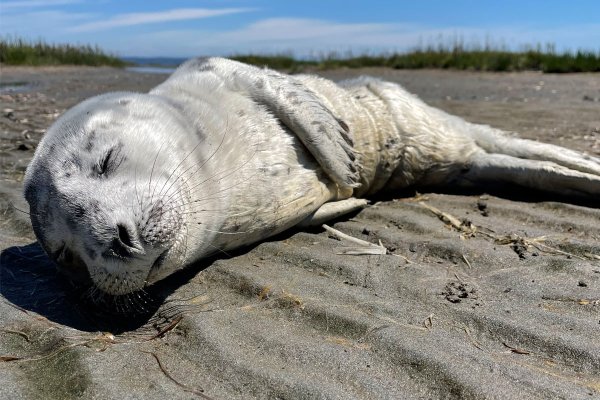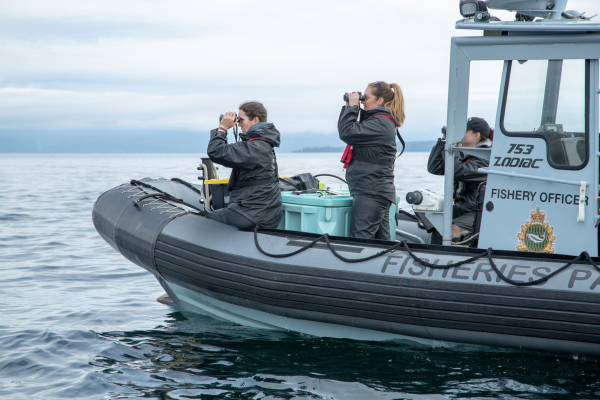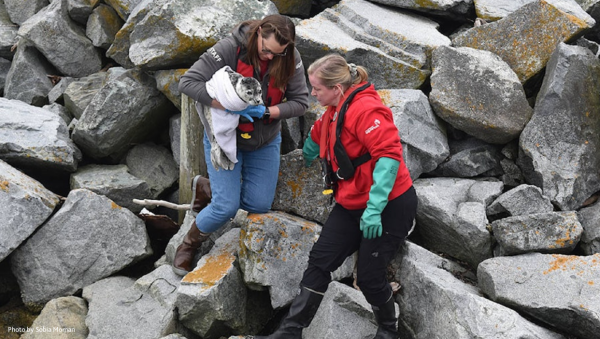Guest Post By Kendra Luckow, Vancouver Aquarium Marine Mammal Rescue Society
Picture this: It’s the middle of summer, you’re just coming back to shore after an early morning paddleboard. As you step onto the beach, you hear a faint crying sound from a nearby rock. Only it’s not a rock, it’s a baby harbour seal – all alone. It stares at you with its big black eyes and continues to cry out. Your first instinct might be to panic, run to it, comfort it, put it back in the water, or even bring it home with you. But here’s what you need to know about harbour seal pups here in BC.

The Scoop on Seals
Let’s first look at what’s normal for seals.
- Harbour seal mothers leave their pups while they go off to forage – don’t worry, they’re usually nearby and watching.
- Harbour seals spend a third of their lives on land, it’s where they rest, sleep, and sunbathe. It’s totally normal.
- Seal pups vocalize to help their mothers locate them; they don’t cry out of sadness. For them, it’s purely communication and survival.

What Not to Do…and Why!
So now that you know what’s normal, here’s what not to do.
- Don’t approach
- Don’t touch
- Don’t feed
- Don’t take it home
(Okay, that last one may be obvious, but you’d be surprised.)
First and foremost, disturbing marine mammals is illegal under Section 7 of the Canadian Fisheries Act.Even if you think a baby seal needs help,interfering can lead to hefty fines, and nobody wants that.
Secondly, they bite. Harbour seals and other marine mammals carry zoonotic diseases. This means that they carry diseases that can be passed to humans such as mycoplasma (known as seal finger) or leptospirosis. These are serious and not worth the risk.
The best chance for a seal pup’s survival is with its mother, interference can cost it that chance.
Oh, and did we mention it’s illegal?

How to be Seal Smart
Okay, now that we’ve covered the big stuff, here’s how to helpwithout accidentally doing harm.
If you encounter a seal pup alone, the best way to help it is by not touching it, staying back, and giving it as much space as possible. A good rule of thumb for all marine mammals is that if it notices you…you’re too close.
If you have dogs with you, leash them, even if you’re at an off-leash dog beach and even if your dog is friendly. It’s not just about protecting the pup; it’s also about keeping your dog safe. Remember:seals can bite and they carry diseases.
Now, sometimes a seal pup is alone AND needs help. If you have your phone on you, take a quick photo from a distance. This gives the rescue team something to go on if help is needed. In British Columbia, you can call:
- Vancouver Aquarium Marine Mammal Rescue Society (VAMMR) at 604-258-SEAL (7325)
- Fisheries and Oceans Canada (DFO) hotline at 1-800-465-4336
Those two numbers connect you to the experts who know what to do next.
What Happens Next?
If you call VAMMR, they will create a case file for the pup you’ve found. They will also ask you a few questions and if you have any photos. Based on photos and a situational assessment, they will determine if the pup:
- Does not need assistance
- Needs to be monitored for possible future assistance (in 12-24 hours)
- Needs to be rescued immediately
Even if the pup isn’t near Vancouver, VAMMR has a wide provincial network ready to respond.

Trust the Experts
Lastly, respect the wildlife and respect the people who protect it.
Rescue staff and volunteers are highly trained and receive hundreds of seal pup calls each year. They work long hours, in difficult conditions, and make tough calls. Know that:
- They care deeply.
- They want to help every animal they can.
- Not every animal can be saved—but they’ll always try.
You can help them by being seal smart.
Essential Resources
General
- BC AdventureSmart
- BC Parks - Homepage
- CWSAA - Alpine Responsibility Code
- BC Parks - Responsible Recreation
- Hello BC - How to Travel Safely & Responsibly
- Indigenous Tourism BC - How to Travel Responsibly
- Leave No Trace
- Outdoor Recreation Council of BC - Recreate Responsibly
- Recycle BC - Pack Lean Leave Clean
- RecycleBC - Pack Lean Leave Clean - Toolkit
- Wilderness Tourism BC - ExploreWildBC Pledge
- BC Parks - KBYG Toilet Edition
- BCSARA - Outdoor Education
- Invasive Species Council of BC - Play Your Part
- Tourism Squamish - Responsible Recreation
- Tourism Whistler - Responsible Travel
- Vancouver North Shore - Know Before You Go
- Fire & Ice Aspiring Geopark
- Átl'ka7tsem/Howe Sound Biosphere
- Adventure Hub - BC Search & Rescue Association
- AdventureSmart Trip Planning App
- BC Wildfire Service App
Boating & Watersports
- Boating BC - Safe Boating
- Freshwater Fisheries Society - Responsible Fishing
- BC Marine Trails - Code of Conduct
- BCSARA - Outdoor Education
- Invasive Species Council of BC - Boaters
- Whale Wise
- Squamish Windsports Society
- BC Marine Trails
- AdventureSmart Water Safety
- AdventureSmart Trip Planning App
- Vancouver Aquarium Marine Mammal Rescue Society
- Paddle BC
Related Impacts

2 Human-Wildlife Conflict
People and pets getting too close to wildlife can lead to conflict, injury, and death.
- BC Parks reservations impacted by bear closures in 2024, up from 106 in 2023
- 128
- Number of black bears euthanized in BC in 2024, down from 603 in 2023
- 303

4 Lack of Respect - People & Environment
From trampling on trails to human-caused wildfires, disrespectful behaviour is creating conflict between user groups and damage to the environment and communities.
- Percentage of human-caused wildfires in BC, down from 42% in 2023.
- 30%

5 Trespassing & Disrespectful Use
Disrespect for sensitive ecosystems, Indigenous land, cultural sites, and private property, is hurting communities, wildlife and the environment